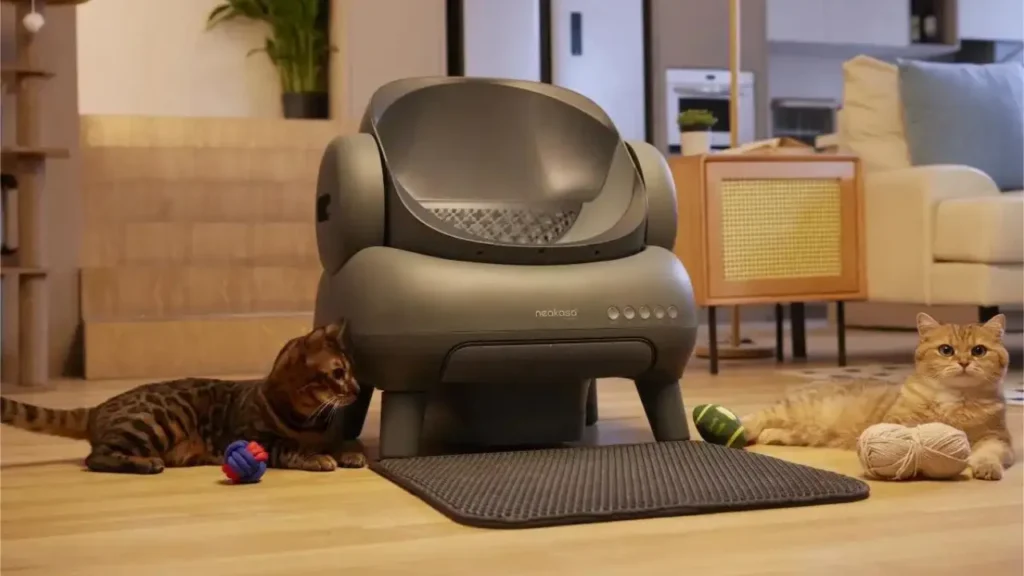Discovering the Litter Box Secrets Your Cat Hides can help you understand your furry friend better. Understanding your cat’s litter box behavior is key to keeping them happy and healthy. In this article, we’ll dive into their quirky habits, hygiene routines, and maybe even decode those mysterious hidden behaviors. Get ready to learn how to create the perfect potty space, tackle any litter box issues, and keep your kitty feeling great!
Hidden Gems from Your Litter Box
- Your cat might prefer a clean litter box.
- The type of litter can affect your cat’s mood.
- Cats may hide signs of litter box issues.
- Location matters—keep it quiet and private.
- Regular cleaning can prevent unwanted behavior.

Summary
What Are the Litter Box Secrets Your Cat Hides?
Cats are mysterious creatures, aren’t they? If you’re a cat owner, you’ve probably wondered what goes on in that little head of theirs. One area that often puzzles us is their litter box behavior. There’s a lot more to it than just doing their business. Understanding your cat’s litter box secrets can unlock a world of insights into their health and happiness. So, let’s dive in!
Understanding Your Cat’s Litter Box Behavior
First off, let’s talk about why your cat even uses a litter box. It’s instinctual. In the wild, cats bury their waste to hide their scent from predators. This behavior is deeply ingrained, and your fluffy friend is no different. If your cat is using the box regularly, it’s a good sign. But what about when they don’t?
Have you ever noticed your cat circling the box or scratching around? These are all clues. They might be trying to tell you something. Maybe the litter isn’t to their liking, or perhaps they’re feeling stressed. Cats can be picky!
Also, keep an eye on their body language. If they seem anxious or hesitant, it might be time to investigate further.
Common Feline Elimination Patterns You Should Know
Cats have their own unique patterns when it comes to elimination. Some might go several times a day, while others might only go once. It really depends on their diet, age, and health.
For instance, if your cat is suddenly using the box more often, it could be a sign of a urinary tract infection. On the flip side, if they’re not going at all, it could indicate constipation or another health issue.
It’s essential to keep track of these patterns. You might even consider keeping a little journal. Note when they go, how often, and any changes in behavior. This information can be super helpful for your vet if you ever need to make a trip.
Cat Hygiene Habits: Keeping It Clean
Keeping the litter box clean is crucial for your cat’s well-being. Cats are naturally clean animals, and a dirty box can lead them to avoid it altogether. So, how often should you scoop? Ideally, you should scoop daily.
And don’t forget to change the litter regularly! Most experts recommend a full change every week or so, depending on how many cats you have.
Also, consider the type of litter you’re using. Some cats prefer clumping litter, while others might like crystal or natural options. It’s all about finding what your cat prefers.
If you haven’t bought your area box yet, try this one, click here.
Want to Know More About This Amazing Product?
If you’re curious about the Neakasa M1 and its standout features, you’ve come to the right place! This innovative product has been making waves for its cutting-edge design and top-tier performance. Whether you’re looking for efficiency, durability, or smart functionality, the Neakasa M1 delivers on all fronts.
For a detailed review, including pros, cons, and real-world performance insights, check out our in-depth analysis here: Neakasa M1 Review – Is It Worth It?.
Stay ahead of the curve and discover why the Neakasa M1 might just be the perfect addition to your tech collection!
Hidden Cat Behaviors: What They Might Be Telling You
Cats communicate in ways we often overlook. For example, if your cat is scratching at the sides of the litter box, they might be feeling stressed or anxious. Maybe they’re trying to tell you that the box is too small or that they need more privacy.
Have you ever seen your cat pawing at the floor outside the box? This behavior can indicate that they’re not satisfied with their current setup. Cats are creatures of habit, and any changes to their environment can trigger stress.
Also, pay attention to how they react when you clean the box. If they seem agitated or avoid it afterward, it might be worth reconsidering your cleaning products. Some scents can be off-putting to cats.
Litter Box Preferences: Finding the Right Fit for Your Feline
Choosing the right litter box is more important than you might think. Size matters! A box that’s too small can be uncomfortable, while one that’s too big might be intimidating.
Most cats prefer a box that’s at least one and a half times their length. And don’t forget about the sides. Some cats like higher sides to feel secure, while others prefer lower ones for easy access.
Also, consider the location of the box. Cats like their privacy but also need to feel safe. Avoid placing the box near loud appliances or in high-traffic areas.
Scent Marking in Cats: Why It Matters
Did you know that cats have scent glands in their paws? When they scratch around in the litter box, they’re not just digging; they’re marking their territory. This behavior is completely normal and actually quite important for their sense of security.
If you have multiple cats, you might notice some territorial behavior. One cat might try to dominate the box, leading to conflicts. In this case, consider having multiple boxes available. A good rule of thumb is to have one box per cat, plus one extra.
The Link Between Cat Anxiety and Litter Box Issues
Anxiety can have a significant impact on your cat’s litter box habits. Changes in the household, like moving to a new home or introducing a new pet, can cause stress.
If your cat suddenly stops using the litter box, it might be worth looking at their environment. Are there any new stressors? Have you changed their routine? Sometimes, even small changes can affect their behavior.
Creating a calm environment can help. Consider using pheromone diffusers or calming sprays designed for cats. These products can help reduce anxiety and encourage your cat to use the litter box.
Feline Health Indicators: What Your Cat’s Litter Box Says
Your cat’s litter box habits can be a window into their health. Changes in urine color, consistency, or frequency can indicate underlying health issues.
For example, if you notice your cat’s urine is darker than usual, it could signal dehydration. On the other hand, if they’re urinating more frequently, it might point to a urinary tract infection or diabetes.
Always keep an eye on their poop too! Healthy poop should be brown and firm. If you notice anything unusual, like diarrhea or blood, it’s time to consult your vet.
Litter Box Maintenance Tips for Happy Cats
Maintaining a litter box is pretty straightforward, but there are some tips to keep in mind.
- Scoop Daily: As mentioned earlier, daily scooping is key. Your cat will appreciate it, and it helps keep odors down.
- Change the Litter: Aim for a full change once a week. Make sure to clean the box itself with warm, soapy water.
- Choose the Right Litter: Experiment with different types to see what your cat prefers.
- Location: Place the box in a quiet, private area, away from their food and water.
- Multiple Boxes: If you have more than one cat, provide enough boxes to avoid territorial disputes.
Weird Cat Litter Box Behaviors Explained
Cats can be quirky, and their litter box behavior is no exception. Have you ever seen your cat sit in the box but not actually go? This might seem odd, but it can be a sign of anxiety or discomfort.
Sometimes, cats will also scratch around the box after they’ve gone. This is their way of covering up their waste, just like they would in the wild.
And then there are those moments when they decide to use the floor instead. It’s frustrating, I know! But this could be a sign that something’s off, whether it’s the litter, the box itself, or even their health.
How to Fix Litter Box Avoidance
If your cat is avoiding the litter box, it’s time to take action. Start by assessing the situation. Is the box clean? Is the litter fresh?
You might also want to consider changing the type of litter. Some cats are picky and might not like the texture or smell of certain brands.
Also, think about the location of the box. If it’s too noisy or in a high-traffic area, your cat might feel uncomfortable using it.
If you’ve tried everything and your cat is still avoiding the box, it might be time for a vet visit to rule out any health issues.
Best Litter Box Setup for Cats: Creating a Cozy Space
Setting up the perfect litter box can make a world of difference. Here’s a quick checklist:
- Size: Choose a box that’s big enough for your cat to turn around in comfortably.
- Type: Decide between covered or uncovered boxes. Some cats prefer the privacy of a covered box, while others like the openness of an uncovered one.
- Litter: Experiment with different types until you find one your cat loves.
- Location: Find a quiet spot that’s easily accessible but not in the way of daily activities.
- Additions: Consider adding a mat underneath to catch any litter that spills out.
Litter Box Training Secrets: Tips for Success
Training your cat to use the litter box is usually pretty straightforward, but it can take some time. Here are some tips to help:
- Start Young: If you have a kitten, introduce them to the litter box as soon as possible.
- Positive Reinforcement: Reward them with treats or praise when they use the box correctly.
- Consistency: Make sure the box is always available and kept clean.
- Be Patient: If your cat has accidents, don’t scold them. Instead, try to understand what might be causing the issue.
- Monitor Changes: Keep an eye on their behavior and make adjustments as needed.
Conclusion
In conclusion, understanding your cat’s litter box secrets is not just about keeping your home clean; it’s about ensuring your furry friend is happy and healthy. By paying attention to their unique behaviors, maintaining a clean environment, and being mindful of their preferences, you can create a comfortable potty space that meets their needs.
Remember, your kitty is trying to communicate with you, and their litter box habits can be a window into their health and well-being. So, keep your eyes peeled for those little signs, and take action when necessary! If you’re eager to dive deeper into the world of feline care, don’t hesitate to check out more articles at Tech Havela.
Your cat will thank you for it!
Frequently Asked Questions
What are Litter Box Secrets Your Cat Hides?
Litter Box Secrets Your Cat Hides are behaviors or habits your cat displays related to their litter box use.
Why does my cat avoid the litter box sometimes?
Cats can avoid the litter box for various reasons, like stress, a dirty box, or even health problems.
How can I tell if my cat is unhappy with their litter box?
Look for signs like refusing to use it, scratching outside the box, or overly aggressive digging.
Do different types of litter really matter?
Yes! Cats can be picky. They may prefer clumping over non-clumping or scented over unscented litter.
What if my cat starts going outside the litter box?
This could mean problems. Your cat might be stressed, sick, or not happy with their litter.
How often should I clean the litter box?
It’s best to scoop daily and do a full clean once a week. Cats love clean spaces!
Are there any tricks to encourage my cat to use the litter box?
Try placing it in a quiet place, using their favorite litter, and keeping it clean. Cats like comfort!
**Sidnir Vieira**
Founder of TechHavela
A passionate pet and tech content creator, helping dog owners across the U.S. make smarter decisions for their furry friends.



